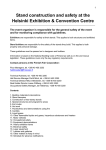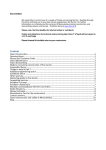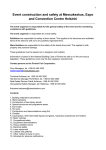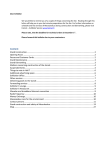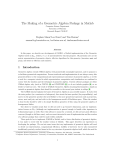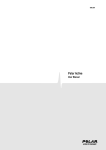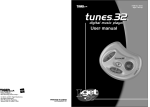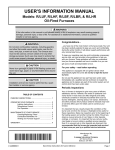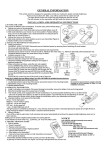Download Stand construction and safety at the Helsinki Fair
Transcript
Stand construction and safety at the Helsinki Exhibition & Convention Centre The event organiser is responsible for the general safety of the event and for ensuring that guidelines are observed. Exhibitors are responsible for the safety of their stands, with respect both to structures and exhibited items. Stand builders are responsible for the safety of the stands they build; this applies to both property damage and personal injury. These guidelines must be passed on to designers and builders. Information is based on the National Building Code of Finland as well as fire and rescue legislation. These guidelines cover only the key requirements included in the pertinent regulations. Contact persons at the Finnish Fair Corporation: Floor managers, tel. +358 40 450 3253 [email protected] Technical advisers, tel. +358 40 450 3250 Hall Service Manager Pertti Mörö, tel. +358 40 450 3250 Technical Director Mika Vakkilainen, tel. +358 40 450 3250 Real Estate Director Lasse Willberg, +358 40 450 3250 Contents 1. Building materials and decorations 2. Stand canopies 3. Construction of two-storey stands 4. Special structures and programme areas 5. Exit routes 6. Hot work 7. Pyrotechnics and demonstrations using fire 8. Candles 9. Liquid gases 10. Other flammable liquids and gases, hazardous substances and heaters 11. Motor vehicles 12. Occupational safety 13. Machinery operation presentations 14. Heavy exhibition items 15. Electrical safety issues 16. Laser equipment 17. Lobbies and galleries 18. Other matters to keep in mind 19. Schedule for advance notifications 1. Building materials and decorations Carpets must have low ignitability, class L (Dfl-s1). Building materials must meet the requirements for public premises. The use of EPS insulation (e.g. styrofoam) as a building material in areas where people assemble is possible. These materials must always be fire-retardant, class S. A certificate verifying the quality of the material and a fire-retardant test certificate must be delivered to the office of the floor manager. Fabrics used for covering, upholstery and decoration should preferably be fireretardant, class SL-2 (B-s1, d0). Otherwise they must be fire-protected. If pyrotechnics are used or hot work is done, materials must be class SL-1 in the immediate vicinity. This will be evaluated on a case-by-case basis. Exceptional building materials and props (such as cardboard, paperboard and bales of hay) that do not meet the requirements of SL-2 (B-s1, d0) must be fire-protected on site. Reliable proof of fire protection must be presented. Materials must have fire classification certificates. If decorations or other materials do not have certificates, they must be fire-protected. If the material used in a decoration has been fire-protected elsewhere, there must be records of its protection and the fabric must have a tag for identification. This includes fabrics used in interior decoration, for example. The Technical Research Centre of Finland issues statements concerning materials that do not have a certificate. A report on the fire classifications of interior decorations must be submitted to the floor manager for approval no less than 45 days before the event. 2. Stand canopies The Helsinki Exhibition & Convention Centre has an automatic sprinkler system, which places restrictions on stand coverings. Stand canopies or other large coverings must not endanger the functioning of the automatic sprinkler system. Fire classified gauze fabric or fire retardant grating meets requirements. Gratings must form a regular pattern on the covered surface. Tents do not meet requirements applying to gauze coverings. Information concerning other types of covering must be submitted to the Finnish Fair Corporation's technical adviser for approval no later than 45 days before the event. The need for fire extinguishing equipment or smoke alarms will be determined by the floor manager. Fire extinguishers must be at least class 27A 144B. 3. Construction of two-storey stands A two-storey stand may be built on the following conditions: Structural drawings and strength calculations must be supplied to the Finnish Fair Corporation's technical adviser at least 45 days before the event. The Finnish Fair Corporation will give its opinion concerning stand construction, but the builder is responsible for the safety of the structure and building work as well as for work supervision. The headroom of the ground floor to the upper storey must be no more than 2,500 mm and no less than 2,200 mm. The number of persons in the upper storey is limited to a maximum of 60 at any time, with a minimum of 1 m2 per person. If the upper storey is larger than 99 m2 or if necessitated by other special reasons (fire load, etc.), the stand must have sprinklers or the exhibitor must arrange a fireguard outside the exhibition's opening hours. The guard's minimum competence requirement is participation in volunteer fire department activities or other suitable training. The railings on the upper floor and on stairways must be 1,100 mm from the floor level to the upper edge of the handrail. The gap between railing structures on the upper floor must be no more than 100 mm both horizontally and vertically. The railing must not have horizontal structures that allow climbing. Intermediate railings must be constructed so that the distance between railings or between railings and the floor does not exceed 500 mm. A two-storey stand must have at least one class 27A 144B fire extinguisher both upstairs and downstairs. Smoke alarms must also be installed in each section. Additional information on dimension and load requirements as well as requirements concerning railings can be obtained from the National Building Code of Finland. 4. Special structures and programme areas Special structures include, for example: Climbing frames Platform areas Raised floors (12 cm or more) Testing areas These areas have been set aside for customers, who wish to test products either independently or under instruction; test driving various vehicles testing sporting gear and other equipment (golf, rollerblading, etc.) testing work machines or equipment Information concerning special structures must be submitted to the technical adviser at least 45 days before the start of construction. Structures must be built according to the National Building Code of Finland and they must be safe for users. The submitted notification must disclose at least the following: general arrangement of the area (limits and access routes) planned measures for ensuring safety contact persons and their contact details Vehicles used in presentations or offered to the audience for testing must have valid motor insurance. 5. Exit routes Exit routes from the halls must be planned according to the following principles: Hall aisles must be well defined and sufficiently wide in the vicinity of the exit doors. If only part of a hall is used, exit routes through empty areas must be planned. Aisles must be at least 2,000 mm wide (between stands). One-storey stands must have sufficient exit routes to the aisles. The number of exits depends on the size of the stand: up to 20 m2, one 900 mm exit route from 20 m2 to 50 m2, two separate 900 mm exit routes from 50 m2 to 100 m2, one 900 mm exit route and one separate 1,200 mm exit route from 100 m2 to 200 m2, two separate 1,200 mm exit routes from 200 m2, the number of exit routes will be determined case-specifically. Instructions concerning exit routes for two-storey stands: The distance to the nearest exit route stairway on the second storey must not exceed 20 metres. The number of exits depends on the size of the second storey: up to 20 m2, one at least 900 mm exit route from 20 m2 to 50 m2, one 1,200 mm exit route or two 900 mm exit routes from 50 m2 to 100 m2, one 1,200 mm exit route and one 900 mm exit route from 100 m2, the number of exit routes will be determined case-specifically. Circular stairs are possible if a stand has more than one exit route. There must be at least one direct exit route, however. (Building Code of Finland F2:2) All exit routes must be marked with proper signs by the builder. 6. Hot work Hot work is work involving sparks or the use of a flame or high heat, which can cause a fire. This includes, among other things, gas and spot welding flame and spot cutting metal cutting and grinding the use of a gas burner or a hot air blower. Persons doing hot work during construction and dismantling hours must have a HOT WORK CARD as well as a written HOT WORK PERMIT issued by the floor manager's office. Persons doing hot work or demonstrations during the fair's opening hours do not need to have a hot work card, but facilities must meet the requirements set for a PERMANENT HOT WORK PLACE. Fire, water and sparks must not be allowed to reach other exhibition areas or the aisles. Gas welding equipment and liquid gas equipment must be equipped with safety devices according to regulations. Written notifications concerning hot work and demonstrations as well as fire extinguishing equipment must be made to the floor manager's office at least 45 days before the event. Additional information: Federation of Finnish Insurance Companies, Safety guidelines for hot work 01/2002. Helsinki Fire and Rescue Department, fire inspectors, tel. +358 9 310 1651 7. Pyrotechnics and demonstrations using fire Demonstrations using fire include, among other things torch demonstrations fire-eating demonstrations the use of a naked flame Pyrotechnical equipment includes, among other things fireworks theatre effects distress rockets flares emergency torches and smoke devices that develop fire or heat when used. Packages of pyrotechnical equipment on display in public facilities must be empty and this must be clearly indicated on packages. Packages must be placed in display cases, especially after ready-to-use packages have been emptied, in which case small amounts of substances may remain in the package. We recommend that exhibitors use new and empty factorysupplied packages. The actual use of pyrotechnical equipment in public facilities always requires advance notification to fire and rescue authorities as well as to the manager of the facility. This must disclose at least an individualised list of the equipment and effects to be used the class, type and number of effects safe distances for effects the planned location of effects the effect construction timetable use date and situation report of fire extinguishing equipment and fire guarding preparations the person in charge, who must have a charger’s work permit a mention of approval from the owner of the facility an inspection time agreed with the fire inspector during the inspection, equipment must be presented in the authentic use environment decorations and props must meet class SL-1 requirements. The abovementioned information must be submitted to the floor manager for approval by no later than 45 days before the event. Permission to use the property for such purposes will be granted on the basis of received reports, but final approval can only be granted in conjunction with the fire inspection. 8. Candles Only safety candles may be used in exhibition facilities. The covering of a safety candle is made of a non-flammable material and the fuel is mineral oil. Safety candles must be placed so that the public does not come in contact with them. 9. Liquid gases Fire and rescue legislation places restrictions on the use of liquid gas indoors. The following should be taken into account in planning: Permission to use liquid gas must be requested from the floor manager at least 45 days before the exhibition. Quantities are limited according to fire section (hall or room), so early requests facilitate approval. The size of gas bottles is 5 kg. Bottles must be installed so that they allow for proper ventilation of the space in question. Spare or empty bottles may not be stored indoors. Liquid gas equipment and pipes must conform to regulations and their condition must be checked in advance. The minimum safety equipment requirement is a fire blanket and a class 27A 144BC fire extinguisher. Requests must indicate: the location plan the amount of liquid gas to be used safety equipment the person in charge of use. 10. Other flammable liquids and gases, hazardous substances and heaters The abovementioned materials may only be kept in fair and exhibition facilities with special permission. Heaters using paraffin (kerosene), petrol (gasoline), diesel oil or gas must be suitable for indoor use. The type of fuel must be visibly marked. Equipment using fuel must be placed on an overflow container. Permission must also be obtained to use and store pressure vessels containing nonflammable gases (for example gases used to inflate balloons). Gas bottles must be attached to something so as to keep them from falling. Empty gas bottles must be clearly marked as such. Only "factory empty" gas bottles can be marked in this way. A notification concerning the use and storage of the above materials must be submitted to the floor manager's office at least 45 days before the exhibition. On the basis of the notification, the floor manager will evaluate the need to obtain a permit from the Helsinki Fire and Rescue Department. Please consult regulations on hazardous substances as well. 11. Motor vehicles Motor vehicles, transport equipment and work equipment (hereinafter "equipment") on display in the exhibition or conference area must have the power turned off at the main switch or have the battery disconnected. The power can be turned on, however, on the following conditions: Power must be turned on to demonstrate equipment. A written notification concerning the need to demonstrate equipment and the quantity of equipment must be made to the floor manager's office at least 45 days before the event. Equipment is new and unused. Keys are kept out of the public's reach. Fire extinguishers at least class 27A 144B C (powder) or at least class 21A 144B (foam or fluid) must be located in the demonstration space as follows: - 1-3 pieces of equipment, 1 extinguisher - 4-7 pieces of equipment, 2 extinguishers - 8-10 pieces of equipment, 3 extinguishers over 10 pieces of equipment, determined case-specifically. Permission to keep the power turned on for used or self-built equipment can only be granted by the rescue authority. Equipment on display in the lobbies or gallery facilities must always have the power turned off. The organizer of the event will monitor compliance with regulations. If regulations are not complied with, equipment can be removed from the premises at the owner's expense. 12. Occupational safety The Helsinki Exhibition & Convention Centre requires that stand constructors observe safe working practices as well as utilise ladders and scaffoldings of a type determined under Government Decree 205/2009 on the Safety of Construction Work. The operators of work machinery and equipment must use the personal protective gear determined in the equipment item’s user manual. Forklift and personal lifting device operators must have a written use authorisation issued by their employers. Before issuing authorisation, the employer must verify that the operator has the skills and abilities required for the appropriate operation of the equipment item in question. Employees must always use fall-preventing protective gear when stationed in the personnel basket of telescopic and articulated boom lifting devices. Use is recommended in the case of scissor lifts. For further information, please contact Occupational Health and Safety Manager Jari Hallamaa, tel. +358 50 387 0060, or the floor manager’s office during the construction/dismantling period of the fair. 13. Machinery operation demonstrations If a demonstration requires hot work, please see section 6. All demonstrations must be performed in a manner that does not endanger bystanders. Objects presenting a risk of crushing or cutting must be equipped with fixed protectors so that someone standing near the demonstration area cannot touch the object with their hands or feet, for example. Alternatively, the demonstration area can be equipped with a fence at least 2 m high (for example wire netting), provided that the work does not involve flying matter or sparks. Additional information: Occupational Safety and Health Inspectorate of Uusimaa, tel. +358 9 774 711 14. Heavy exhibition items If the load caused by an exhibition item in halls 1, 2, 3, 6 and 7 exceeds 10 kN/m² (1,000 kg/m²) or 7 kN/m² (700 kg/m²) in halls 4 or 5, their placing is always subject to separate agreement with the Real Estate Manager. 15. Electrical safety issues Electrical installations performed at exhibitions must conform to the requirements of standard SFS 6000-7-711 (EXHIBITIONS, PRESENTATIONS AND EXHIBITION SECTIONS). Standards can be purchased from the Finnish Standards Association SFS (www.sfs.fi) If builders use their own construction-site electricity distribution devices or comparable equipment, they must ensure that all 32A and smaller power points are equipped with a 30mA residual-current device. Items placed into exhibition sections must have plug-equipped cords. Only grounded extension cords equipped with plugs and extension sockets may be used in exhibition sections. Builders may not themselves perform any connection wiring work at the Helsinki Exhibition & Convention Centre/other premises of the Finnish Fair Corporation; when necessary, a connection wiring service can be procured against separate payment. A separate fee will be levied if the Finnish Fair Corporation has to perform an electrical wiring inspection at an exhibition section. Halogen lighting, heaters and other equipment that generate a lot of heat may not be installed without appropriate protective measures, which prevent scalding and protect against the spread of fire. 16. Laser equipment Radiation and Nuclear Safety Authority Finland issues guidelines and monitors the use of laser equipment at public occasions. Radiation and Nuclear Safety Authority Finland does not conduct on-site inspections of lowpower laser equipment (under 5 mW) used at public occasions. These must, however: be used in a professional manner in the case of battery-operated or electrical equipment (voltage under 50V), be approved by the Department for Occupational Safety and Health at the Ministry of Social Affairs and Health in the case of other equipment, be approved by an EU or EEA country have the required warnings and type and approval marks have the required installation, warning and operating instructions in Finnish and if necessary in Swedish. Radiation and Nuclear Safety Authority Finland must always be contacted concerning the use or presentation of high-power laser equipment, which is in safety class 3B and has an output power of over 5mW. Additional information: Radiation and Nuclear Safety Authority Finland, tel. +358 9 759 881. 17. Lobbies and galleries The planning of advertising spots and other spaces in lobbies and galleries must observe the separate instructions pertaining to them. You should consult the technical adviser when designing activities or stands. If a motor vehicle is on display, the battery must be disconnected or the power must be turned off at the main switch. 18. Other matters to keep in mind chairs installed for spectators must be attached to one another. if food is prepared, it is important to protect the public from coming in contact with hot surfaces. The minimum safety equipment requirement for food preparation is a fire blanket or, in special cases, a fire extinguisher of at least class 27A 144BC. Requirements set by the Environment Centre must also be met. lamps and advertising lights that produce heat must be installed so that people or flammable materials will not be harmed by them. Lamps must be attached firmly in place. Saunas and sauna stoves can be on display (with the power connected), provided the following conditions are met: - When the sauna is turned on, a guard must be constantly on duty. After the power has been turned off, the guard must remain on duty for one hour. - Brochures or flammable materials must not be placed inside the sauna or near the stove. - Demonstrations must be supervised and the necessary railings must be installed to prevent contact with hot surfaces. - Notification of sauna stoves and equipment must be submitted to the floor manager for approval at least 45 days before the event. The notification must show the sauna floor plan and the location of the stove. 19. Schedule for advance notifications Subject Deadline Fire classification of decorations, fabrics and advertising banners Stand canopies 45 days before the event 45 days before the event Two-storey stands 45 days before the event Special structures and 45 days before the programme areas event Exit routes in 200+ square metre 45 days before the sections event Hot work 45 days before the event Pyrotechnics and 45 days before the demonstrations using fire event Liquid gas use 45 days before the event Flammable liquids and gases 45 days before the event Non-flammable gases and 45 days before the pressure containers event Hazardous substances 45 days before the (chemicals) event Heating equipment use 45 days before the demonstrations event Demonstrating powered-up 45 days before the vehicles event Presentations of saunas and 45 days before the stoves event Recipient of notification Floor manager Technical adviser Technical adviser Technical adviser Floor manager Floor manager Floor manager Floor manager Floor manager Floor manager Floor manager Floor manager Floor manager Floor manager Copying of this document is prohibited under the Copyright Act without the permission of the Finnish Fair Corporation. We reserve the right to make changes. 31 August 2011 The Finnish Fair Corporation P.O. Box 21, Messuaukio 1 FIN-00521 Helsinki Tel. +358 40 450 3250 Internet: www.finnexpo.fi











